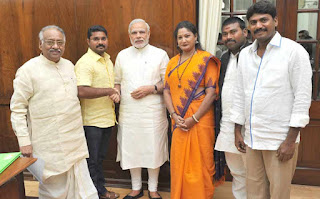The saree dates back to the Indus valley
civilisation which flourished between 2800 BC and 1800 BC. This unstitched garment of sheer beauty,
elegance and charm continues to charm women from every region in India even
in the present day. Here is a lowdown of four popular
handloom sarees from the four corners of the country:
North Indian Weave: Benarasi, Banaras, UP
Origin:
Historians trace silk work to vedic times. Hiranya finds mention in the revered Rig Vedas as the attire of the gods. Some scholars believe that this description comes close to the embellished zari work, synonymous with Banarasi silk sarees. The timeless Jataka tales and Pali texts support the evidence of a bustling cloth trade on the banks of the Ganga, in Kashi.
Weaving Process:
The zari threads are made as follows: Flattened thin metallic strips are drawn from gold alloys. These strips are then wound around silk yarns. The threads are then flattened using machines. Often they are passed through a brightener to increase their sheen.
Special Features:
The saree designs are created on paper – the pattern is punched into the paper, making it look much like Braille.
Motifs:
Back in the Mughal era, designs consisted of Islamic motifs such as floral patterns, stylized leaves etc. During the British era, the Victorians often demanded geometric patterns. Today, one can find a variety of motifs like Hindu gods embossed on cushion covers etc.
Time Taken:
Minimum time taken to make an ordinary Banarasi saree is 15days. It varies based on the intricacy and detailing involved.
South Indian Weave: Kanjeevaram Saree, Kanchipuram, Tamil Nadu
Origin:
Kanjeevaram silk saree is a creation of the craftsmen living in Kanchipuram situated near Bangalore. The silk used in the creation of this saree is extremely fine as well as durable and is one of the most popular forms of silk in Chennai.
Weaving Process:
The procedure commences with the task of preparing the thread, which is used at the weaver’s loom. This involves twisting the thread and then dyeing and drying it in the sun. The border, the body and the pallu of the sari are created separately by the weaver.
Motifs:
In Indian Kanchipuram sarees, designs replicating Pallava temples, palaces and paintings are depicted. However, these days one can see scenes from great epics, Ramayana and Mahabharata, along with the Bhagwad Gita being as motifs. Tribal designs as well as contemporary patterns are also seen.
Time Taken:
Minimum time taken to make a simple Kanjeevaram saree is 12days. It varies based on the intricacy and detailing involved.
East Indian Weave: Sambalpuri, Sambalpur, Odisha
Origin:
Also known as Bomkai sarees, they have been a part of the rich culture of Odisha since 600 BC. There is historic reference that the designs adorning these sarees are inspired by the cave paintings of Khandagirithat were built during 2nd century BCE. These sarees are woven with the jala technique.
Weaving technique:
Traditional jaalas are used for weaving Bomkai sarees where wooden jaalas are used for tying which is step ahead of the tie and dye technique.
Motifs: Bomkai sarees commonly depict images of flora, fauna or geometrical patterns. Popular patterns like rukha(pestle), karela(bittergourd), dambaroo(hour-glass shaped drum), kanthiphoola(small flowers) mayor/mayuri(peacock), fish and other custom made designs take centre stage in this enticing weave. Traditional motifs like shankha(shell), chakra(wheel), phula(flower), adorn the saree.
Time Taken:
Minimum time taken to make a Sambalpuri saree is 20 to 25days.
West Indian weave: Bandhani, Rajasthan
Origin:
‘Bandhani’ is derived from the word ‘Bandhan’ which means tying up. It is an ancient art practice that is mainly used in the state of Rajasthan. Some 5000 years ago Indian tie and dye or Bandhani was started. Centres in Rajasthan like Jaipur, Sikar, Bhilwara, Udaipur, Bikaner, Ajmer produce odhnis, sarees and turbans in Bandhani. Another school of thought says Bandhani work in India was started by the Muslim Khatri community of Kutch.
Weaving Process:
The art of Bandhaniis a highly skilled process. The technique involves dyeing a fabric which is tied tightly with a thread at several points, thus producing a variety of patterns like leheriya, mothra, ekdali and shikari, depending on the manner in which the cloth is tied.
Motifs: Very elaborate motifs are made, in tie and dye work. These include flowers, creepers, bells and jalas. Knots are placed in clusters, each with a different name, for example, a single dot is called ekdali, three knots is called tri kunti and four knots is chaubundi. such clusters are worked intricately into patterns such as Shikhar(mountain like), Jaaldhar (web like), Beldaar(vine like )etc.
Time Taken:
Minimum time taken to make a Bandhani saree is 20 days.
Image Courtesy:
http://bit.ly/2vRkHD3
http://bit.ly/2ffoTWU
http://bit.ly/2w4ytWU
http://bit.ly/2y2CjgM
http://bit.ly/2wYr2j7
http://bit.ly/2vRlbcw
http://bit.ly/2wUAB3f
http://bit.ly/2wmqe3X
http://bit.ly/2h0xUXP
http://bit.ly/2f2cpVG

























